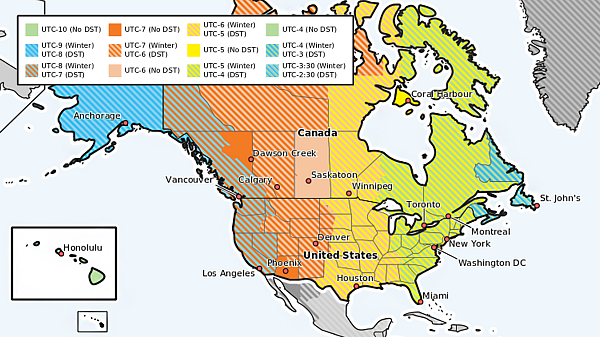Daylight Saving Time Ends in USA & Canada
In the United States, Canada, and Mexico's northern border cities, Daylight Saving Time (DST) ends on Sunday, November 3, 2019.


DST ends on November 3, 2019.
©timeanddate.com
Clocks will be set back 1 hour from 02:00 (2 am) to 01:00 (1 am) in each time zone.
DST in the US starts again on Sunday, March 8, 2020.
As always, Europe will end DST a week before the US, on October 27, 2019.
Affects Most of the US
On November 3, the time will change in almost all of the United States.
Only the following areas do not change their clocks:
- Hawaii and most of Arizona.
- The US dependencies American Samoa, Guam, Puerto Rico, the Northern Marina Islands, the US Minor Outlying Islands, and the US Virgin Islands.
State Clock Change Confusion
Several US states are proposing or have passed bills in favor of permanent DST. However, none have received congressional approval to abolish the time change. For this to happen, Congress first has to pass a federal law allowing states to observe DST year-round.
Recent developments include:
- Florida's 2018 bill for permanent DST, dubbed the “Sunshine Protection Act,” is awaiting congressional approval.
- In May 2019, the governor of Washington signed House Bill 1196 in favor of permanent DST. It is also awaiting congressional approval.
- The govenor of Oregon signed Senate Bill 320 for permanent DST in June 2019, though the bill stipulates that the law will only be implemented if Washington and California approve their all-year DST policies.
- In May 2019, Tennessee governor Bill Lee signed Senate Bill 1100, establishing DST as standard time. This bill is awaiting congressional approval.
- In California, Assemblymember Kansen Chu's DST bill has been pushed to 2020. In 2018, 60% of Californians voted in favor of permanent DST in Proposition 7.
DST Change in Canada
In Canada, clocks will change in almost all areas, except:
- Most of Saskatchewan
- Some locations in Québec east of 63° west longitude (e.g., Blanc-Sablon)
- Southampton Island
- Some areas in British Columbia
Canadians Want to Ditch the Switch
In a recent survey, more than 93% of the population in British Columbia stated that they would like to stay on permanent DST. Although Premier John Horgan has expressed support for the idea, he said introducing relevant legislation hinges on the US state of Washington making the permanent change. “Blame the United States, particularly the Congress, which is being gridlocked by Donald Trump,” he told CTV News on October 4, 2019.
In Manitoba, there is a bit of confusion whether or not the clocks will be set back 1 hour to standard time this fall. Although Bill 205 was defeated (scroll to 205) on April 11, 2019, the governmental website does not clearly state so.
Mexico: Northern Border Cities Follow the US
Some northern Mexican border towns, such as Tijuana and Juarez (Ciudad Juárez), end DST on November 3, along with the US and Canada.
The rest of Mexico ends DST 1 week earlier on Sunday, October 27, 2019—on the same date as Europe's DST change.
The states of Sonora and Quintana Roo do not observe DST at all, so the clocks will not change there.
Other Countries and Territories
DST will also end on November 3 in Cuba, Bermuda, the Bahamas, Saint Pierre and Miquelon, and Thule Air Base in Greenland.
Upcoming DST changes worldwide
Set Clocks Back or Ahead?
To remember which way to set your watch, keep in mind one of these sayings: “Spring forward, fall back” or “Spring ahead, fall behind.” The clocks spring ahead (= losing 1 hour) in the spring when DST starts, and they fall back 1 hour (= gaining 1 hour) when DST ends in the fall.